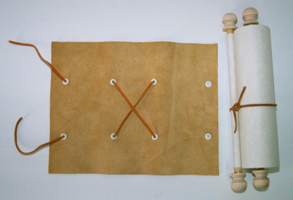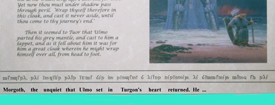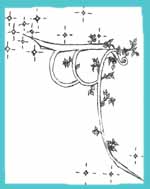SPECIAL GUEST:
The Scrolls of Middle-earth : II. Description of the Scroll
Reading the Epic Tales in Original Form
II. Description of the Scroll
A. The Components
Physically, a scroll is composed of parchment-style paper mounted on wooden dowel rods with end caps. The scroll is encased in a suede leather sheet of standard paper size. There are several holes punched in the suede to hold a leather thong that ties the scroll shut when stored. The holes in the casing have white grommets to add cache.
The end caps and the blank first and last pages glued to each of the dowel rods are attached using standard wood glue. Each page of the scroll is glued to its neighbor using standard rubber cement. The page "joints" need to be flexible and not crack when dry because the paper will be rolled up when stored.
B. The Page Layout
The story is scanned into a word processor, edited, and then formatted for two column, landscape view. The TrueType font is Lucida Calligraphy Italic using Microsoft Word 97 and later, Powerpoint 97. I imported appropriate pictures as bitmapped files scanned from my collection of books and calendars. Other decorative images are from clip-art libraries. I placed a thorn bush image at the end of sections and a stylized fish image just before the section where Ulmo appears to Tuor in Tuor Comes To Gondolin.
The borders, top and bottom, serve a dual purpose. First they add "flavor" as a decorative border. Second, they provide additional story material enhancing the main text. I compiled short story lines from several sections of the Silmarillion that describe ancillary events that pertain to the main characters. I set the "border stories" in a TrueType font I created several years ago using CorelDraw 4.0. I named the font Lothlorian. It is a simple letter by letter substitution of an Elvish character for an English equivalent. I formatted the "border stories" so they matched the total number of pages of the main scroll story. Finally, at the beginning and the end I added an additional page that contains the entire alphabet and numbers 0 to 9 in each border - one in Lothlorian and the other in English. The observant reader will figure out how to "decode" the borders given these hints.
A few general comments about the construction of the Lothlorian font:
- 26 characters for a direct letter-by-letter substitution for the English alphabet.
- Vowels all have the same "root" of a vertical line resembling a lower case "i". Each vowel has its own additional symbol above the root. These are partially derived from Bilbo's script wherein vowels were diacritical marks made above a line of text composed only of consonants or consonant combinations. I somewhat rationalized specific symbols as follows: connect the three dots in the "a" and you get a sort-of "a" shape; the "i" is one dot; and the curl for the "o" resembles that vowel in English.
- There are no consonant combinations. All are single sounds as in English. I made the font with typing on a computer in mind and I wished to avoid multiple keystroke combinations.
- I tried to match up known symbols as already specified in the Tolkien stories. So the symbol for "g" was easy to decide because it was on the fireworks at Bilbo's party as the mark of their manufacturer, Gandalf. Then I tried to match up symbols for single consonant sounds as provided in the appendix to The Return of the King. Finally I made adjustments but tried to stay within the bounds set by the Professor to make similar symbols for similar sounds as made by the shape of the human mouth and tongue. Compare the symbols of the following letters with each other:
- f & v - upper front teeth on lower lip: "f" is aspirated, while "v" is voiced.
- b & d
- p & t
- c & q
- m & n
- g & j
The two original scrolls did not have borders. Borders did not occur to me until some months after I made the first versions in late 1999. When I experimented with headers and footers though I could not get the proper effect using Microsoft Word 97. Any header or footer I made on the first page was automatically reproduced on all pages in the document. I may have been able to achieve the desired effect of a unique line of text on each page using the section breaks, but I had already used those to switch between the two column layout of the text and pictures. So rather than edit my original and potentially lose the formatting, I copied the main text and graphics over to Powerpoint 97. I then added separate text boxes for the header and footer on each slide to obtain the borders.
C. The Story Sequence
The sequence of reading the scroll is:
- The Alphabet page which is a blank page with borders of the alphabet in Lothlorian and English.
- The Title page, with the beginnings of each border story. The border stories continue until the last page of the main text.
- An Introduction page with a brief summary of some major event leading up to the present main story of the scroll. In the case of
- Tuor and His Coming to Gondolin the opening synopsis describes the final retreat from the Battle of Unnumbered Tears. Huor and Hurin (Tuor's father and uncle) and the men of Dor-lomin guarded the Fens of Serech with their lives while Turgon and the Gondothlim retreated back to their hidden city.
- The Fall of Gondolin the synopsis is composed of the last 3 paragraphs or so from Tuor and His Coming to Gondolin.
- The Main Story begins and continues for about 60 pages. It is composed of text interspaced with pictures from professional artists.
- The Alphabet page again.
D. The Storage Chest
To complete the ensemble, my son Cameron, is decorating a wooden box with "illuminations" similar to the Celtic Book of Kells. The box will hold the scrolls and any other Tolkien "artifacts". Pictured here are two of his sketches which he has recently begun to draw onto the box. The plan is to paint them on rather than carve them because of the fine detail of the figures.
NEXT: Motivation for Making the Scrolls
|
![[ Green Books ]](http://img-greenbooks.theonering.net/images/gb_logo.gif)
![[ Green Books - Exploring the Words and Worlds of J.R.R. Tolkien ]](http://img-greenbooks.theonering.net/images/gb_topnav.gif)





